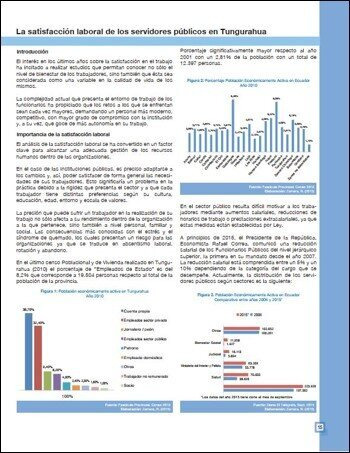The work satisfaction of public servants in Tungurahua
Main Article Content
Abstract
Brief analysis of job satisfaction in the public sector of Tungurahua.
DOI: https://doi.org/10.31164/bcoyu.7.2015.583
URL: http://revistas.uta.edu.ec/erevista/index.php/bcoyu/article/view/583
Downloads
Article Details

This work is licensed under a Creative Commons Attribution-NonCommercial 4.0 International License.
![]()
The publications of the Boletín de Coyuntura are licensed under a Creative Commons Attribution-NonCommercial 4.0 International License (CC BY-NC 4.0). The Universidad Técnica de Ambato retains the copyright of the published works, and favors and allows the reuse of these, as long as: the authorship and original source of publication is cited, and they are not used for commercial or onerous purposes. The intellectual property of the published articles belongs to the authors.
References
Álvarez, P. (2009). Los riesgos psicosociales y su reconocimiento como enfermedad ocupacional: Consecuencias legales y económicas. Revista Telos, N.º 11 (3), Pp. 367 – 385.
Carlin, M. y Garcés de los Fayos Ruiz, E. (2010): El síndrome de Burnout: Evolución histórica desde el contexto laboral al ámbito deportivo. Anales de Psicología, Vol. 26, N.º 1 (enero), Pp. 169 – 180.
Cordes, C. y Dougherty, T. (1993): A Review and an Integration of Research on Job Burnout. The Academy of Management Review, Vol. 18, N.º 4, oct., 1993, Pp. 621 – 656.
Cox, T et al. (2005). Research on Work - related stress. Luxemburgo. Agencia Europea para la seguridad y salud en el trabajo.
Diario El Telégrafo (2015): http://www.telegrafo.com.ec/politica/item/so-lo-el-9-de-empleados-es-del-sector-publico.html
Fascículo Provincial Tungurahua. Resultados de Censo 2010.
Figueiredo-Ferraz, H. et al. (2009): Prevalencia Del Síndrome de Quemarse por El Trabajo (Burnout) en una muestra de maestros portugueses. Publicado en la Revista Aletheia, Vol. 29, Jan-Jun 2009, Pp. 6 – 15.
Gil-Monte, P. et al. (2006): Relación entre el Síndrome de Quemarse por el trabajo (Burnout) y Síntomas Cardiovasculares: Un Estudio en Técnicos de Prevención de Riesgos Laborales. Revista Interamericana de Psicología, Vol. 40, N.º 2, Pp. 227 – 232.
Hackman, J. R. and Oldham, G. R. (1.980): Work redesign. Massachusetts: Adisson – Wesley Reading.
Herzberg, F., Mausner, B., Bloch Snyderman, B. (1959): The Motivation to Work. Versión en castellano “La motivación para el trabajo”. Wiley International Co.
Jackson, C. y Manning, M. (1995): Burnout and Health Care Utilization. Journal of Health and Human Services Administration, Vol. 18, N.º 1, Summer – 1995, Pp. 31 – 43.
Kast, F.E. and Rosenzweig, J.E. (1985): Organization and Management: A Systems and contingency approach. McGraw Hill, 4th. Edition.
Labrador, F. y Crespo, M. (1993): Estrés. Publicado en Madrid, Eudema.
Lozano, L. et al. (2007): Descripción de los niveles de Burnout en diferentes colectivos profesionales. Aula Abierta 2007, Vol. 36, N.º 1-2, Pp. 79 – 88.
Malach, A. (2002): The changing psychological at work and employee burnout. Journal of Health and Human Services Administration, Vol. 25, N.º 1, Summer – 2002, Pp. 11 – 32.
Maslach, C. y Jackson, S. (1981): The measurement of experienced burnout. Journal of Occupational Behaviour, Vol. 2, Pp. 99 – 113.
McClelland, D.C. (1989): Human Motivation. Traducido al Castellano como Estudio de la Motivación Humana, por Narcea, S.A. de Ediciones, Madrid.
Rissén, D. (2006): Repetitive and monotonous work among women: Psychophysiological and subjective stress reactions, muscle activity and neck and shoulder pain. Department of Psychology, Stockholm University.


